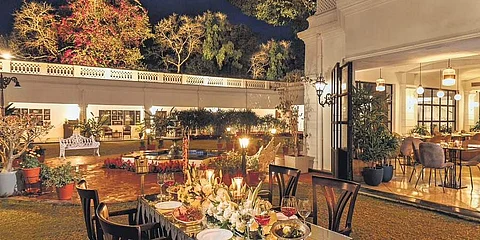

Reviving and purveying royal cuisine is the common culinary trope these days. Suddenly, home cooks in purani Dilli and former Rajasthani principalities are discovering grandma’s old recipe books—the more tattered the better—that lay claim to lineages dating back centuries that involve lost traditions and tireless khansamas with an eclectic flair for satisfying demanding royal palates. Many of these have percolated into the recipes of palace hotels like Jehan Numa in Bhopal which dominates Shyamala Hill.
The palace was a statement built in 1890, a power statement by General Obaidullah Khan, Commander-in-Chief of the Bhopal State Force, and the second son of Nawab Sultana Jehan Begum. As was common during the confusing but grand colonial age, the palace is a mix of British, Italian Renaissance and Classical Greek styles. Though it’s not certain what dishes the present Nawab family prefers, the menu with its Mughal epicurean roots offers a 13-course meal at the General’s Table.
Can Obaidullah Khan attest to its authenticity? His great-grandson Faiz Rashid, the Director of Jehan Numa Group of Hotels, thinks so. “Authentic home-cooked flavours when creatively paired, make for a true gastronomical journey.” Bhopal was a rare state once ruled by Begums. The kitchen was not where the ruling ladies spent their time, hence, leaving the khansamas to develop a trademark style.
Such as tenderising the meat and pounding with a wooden mallet to make Filfora, a mildly spiced, succulent mutton dish that takes—hold your breath—nine whole hours of toil. Chef Jeevan Singh, who heads three restaurants within the hotel, says the chefs are trained by the kothi khansamas. He explains, “We follow the original techniques and use the same old utensils. Spices are ground by hand as per the original recipe. We use iron, copper and bronze utensils to make the fare for the General’s Table.”
Fresh coriander is a key ingredient in all Bhopali gravies. The rezala is green, while its delightful Bengali version is usually white. The region has many freshwater lakes and tarns where lotuses and waterlilies grow in profusion. Hence, soft and firm koftas made from nadru (lotus stem) paired with steamed rice (Rampuri variant), is a unique dish on the menu.
Bhopali cuisine does not resemble rich Lucknowi food, although it’s impossible for Northern royal cuisines to escape the Mughal influence completely. The change is that Bhopali royal food is low in spice and fat and high in flavour and aroma.
There is the typical but flavourful ensemble of pickles, pastes and papads. The table itself is laid in a garden full of petunias and lit by a hundred candles. The Murgh Badam ka Shorba has a trademark nutty touch. Part of the course is the piquant Dahi ke Kebabs, followed by a coarser, meatier galouti kebab. The chef blends aromatic spices effortlessly with the meat. Pairing a morsel of soft Khameeri Roti (fermented flatbread) with Kachumbar Karela, yields inspiring results.
The crowning point, pun intended, is the traditional yakhni pulao and th delicious murgh makhane ka korma. The desserts served are Shahi Tukda made with freshly baked bread at the in-house bakery, an amber coloured chana Dal ka Halwa and the iconic Sheer Khorma. Between Faiz and the kitchen staff, the General’s Table presents a gourmet experience where old feasts are renewed with passion and skill.
Ingredients
✥Vermicelli: 25 gm
✥Clarified butter: 15 gm
✥A pinch of powdered green cardamom
✥Milk: 1 L
✥Green cardamom (whole): 1-2 pieces
✥Sugar: 150 gm
✥Almonds, cut into thin slivers: 10
✥Pistachios, cut into thin slivers: 10
✥Raisins: 10
Method
✥Heat ghee in a pan, brown the vermicelli mixed with the cardamom powder and keep aside
✥Heat milk with whole cardamom till boiling point, then simmer and keep stirring
✥Once the milk thickens a bit, add the roasted vermicelli. Keep cooking and then add sugar.
✥ Cook for another five minutes, set aside to cool
✥ Sprinkle slivers of nuts and whole raisins on top and serve